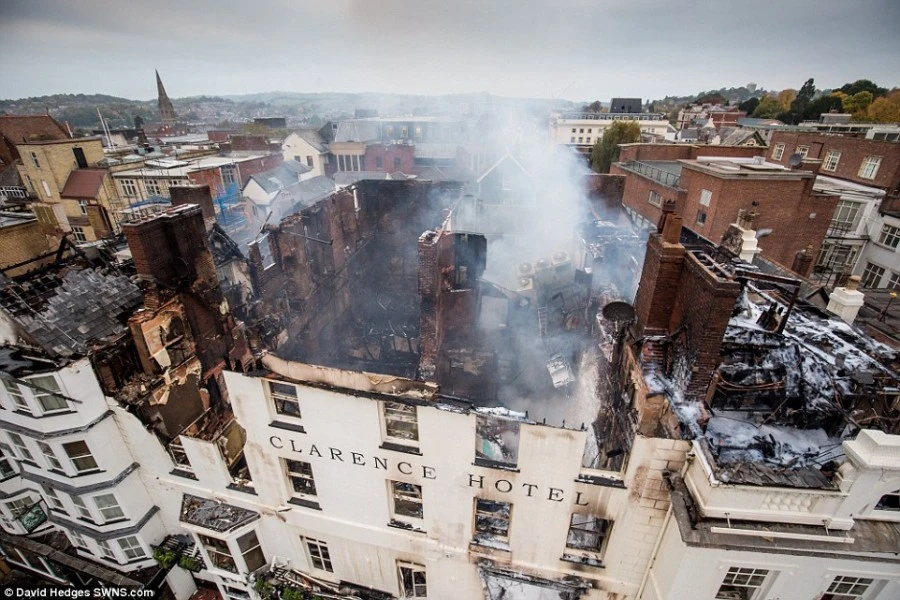The fire that destroyed Exeter’s Royal Clarence Hotel – the UK’s oldest hotel – on Friday is believed to have started at about 5am in a building on Cathedral Green.
It then spread to other buildings including the hotel, a historic landmark in the city centre that dates back to 1769.
How can a fire that started in an adjacent building have spread and caused so much damage? This is the question many people will be asking and to find the answer we need three questions answered:
What was the cause of the fire?
We know from media reports that 18 Cathedral Yard, where the fire is believed to have started, was in the process of being converted to high spec luxury flats.
So was there any hot work carried out the day before? Was any electrical equipment left on overnight? Was the site secure and were there any special fire safety measures in place due to the nature and age of surrounding buildings?
These and many more questions need to by looked at by the investigation team.
"At one point it was reported that “all visible flames had gone” – so how did the fire manage to spread from the building of origin to adjacent buildings when the fire service was present?"
Why did the fire spread to adjacent buildings?
At one point it was reported that “all visible flames had gone” – so how did the fire manage to spread from the building of origin to adjacent buildings, including the Royal Clarence Hotel, when the fire service was present? The explanation at the time appears to blame hidden voids, which is the reason given for many fires in this type of building.
As this was foreseeable, why were special precautions and investigations not put in place to identify and protect these areas? This question is a very important one because it could have an impact on other densely populated historic city centres together with how fire safety precautions are put in place and how firefighting operations are undertaken.
The spread of fire between buildings is something that has been recognised for many years – even earlier than the Great Fire of London in 1666 – and there have long been regulations in place to stop fire spreading between buildings, especially at roof level – so what was in place here?
It is thought that fire spread through hidden voids but a lot of technology is available today to detect voids, such as thermal imaging, ultrasound, as well as by visual inspection and even drones
Were there any firewalls in place between buildings or fixed installations to protect openings? Were there any special precautions to prevent fire spreading between adjacent roofs, or did we just think that it would never happen?
Given the historic nature of this area we must ask why fire safety precautions appeared to fail and why this problem was not foreseen before the fire.
Did the local authority building inspector require any active or passive fire safety measures? Did the fire service identify the problem previously, given the number of similar incidents around the country?
And did any of the fire risk assessments identify any problem? Very important questions that I think need answers.
From photographs it can be clearly seen that there are many similar features with previous fires in Dartmouth, Hereford and Chester – so what did we learn from these?
As stated previously, it is thought that the fire was able to spread through hidden voids but a lot of technology is available today to detect voids, such as thermal imaging, ultrasound, as well as by visual inspection and even drones. So had any of this been carried out prior to the fire and had any special precautions been put in place?
Some reports also highlight a lack of water as a problem, but this should have been apparent before the fire and plans should have been put in place for such an eventuality.
So what can be done to prevent similar fires?
A great deal of research has been done to highlight this problem and many detailed investigations into past fires have detailed the problems and what can de done to protect our heritage and history. Many people highlight cost and disruption as being a reason not to invest in the protection of our heritage, but if we continue to accept these reasons we will continue to see these buildings go up in flames.
There is little doubt that this fire is a serious failing of fire safety arrangements for the protection of historic buildings. The only positive to come out of this is that no one appears to have been injured, but all of these failings should have been foreseen.
So we need to ask the question: How did this happen and what can we do in the future to prevent it happening again? Sadly, this is not the first time the question has been asked and I suspect it won’t be the last.
When I looked at the Clandon Park Fire I stated: “What of course we do know is that if fires start in these old buildings the results can be devastating and sprinklers would certainly have helped, but there is a reluctance to install these types of systems in buildings like this due to cost and disruption.
“There have been tremendous advances in fire detection and warning technology and there are systems that can detect very small shouldering fires and alert the occupiers and fire service in minutes.
“In addition to this, there are materials and methods available today that can improve the fire resistance of doors and structures without detracting from the overall appearance – so were these installed here or were they too costly as well?”
SOURCE: IFSECGLOBAL.COM





